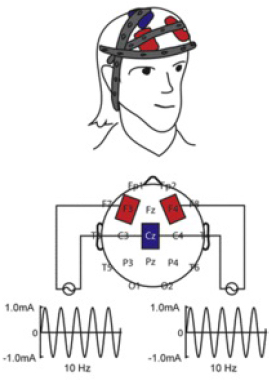Following up on the recent Flavio Frohlich paper. Some details here in the abstract about how the boost in creativity was achieved.

Creativity, the ability to produce innovative ideas, is a key higher-order cognitive function that is poorly understood. At the level of macroscopic cortical network dynamics, recent electroencephalography (EEG) data suggests that cortical oscillations in the alpha frequency band (8–12 Hz) are correlated with creative thinking. However, whether alpha oscillations play a functional role in creativity has remained unknown. Here we show that creativity is increased by enhancing alpha power using 10 Hz transcranial alternating current stimulation (10 Hz-tACS) of the frontal cortex. In a study of 20 healthy participants with a randomized, balanced cross-over design, we found a significant improvement of 7.4% in the Creativity Index measured by the Torrance Test of Creative Thinking (TTCT), a comprehensive and most frequently used assay of creative potential and strengths. In a second similar study with 20 subjects, 40 Hz-tACS was used instead of 10 Hz-tACS to rule out a general “electrical stimulation” effect. No significant change in the Creativity Index was found for such frontal 40 Hz stimulation. Our results suggest that alpha activity in frontal brain areas is selectively involved in creativity; this enhancement represents the first demonstration of specific neuronal dynamics that drive creativity and can be modulated by non-invasive brain stimulation. Our findings agree with the model that alpha recruitment increases with internal processing demands and is involved in inhibitory top-down control, which is an important requirement for creative ideation.
There’s a paywall to the full paper, but Kurzweil.net has the details.
Alpha-rhythm brain stimulation shown to boost creativity
